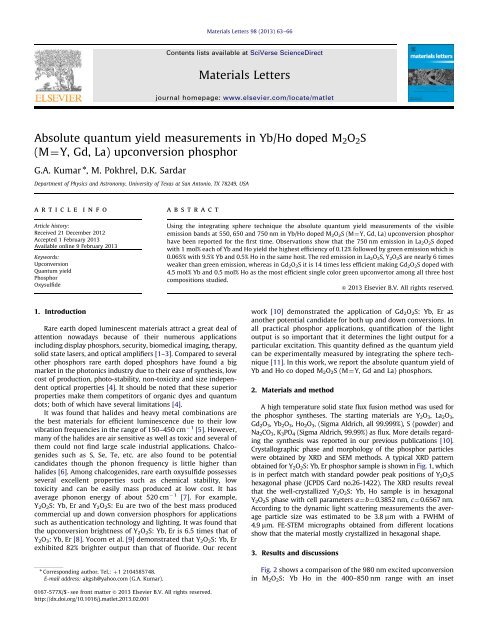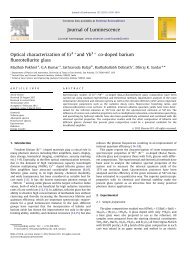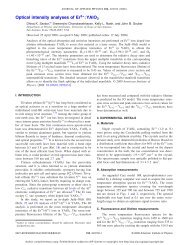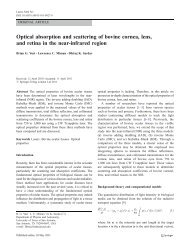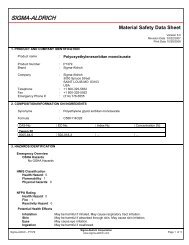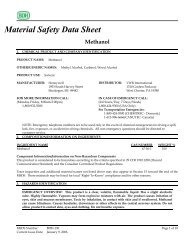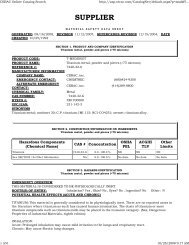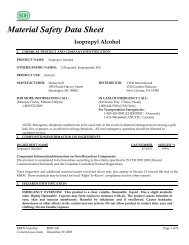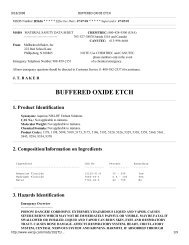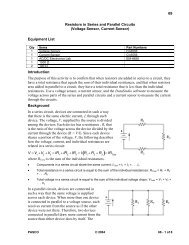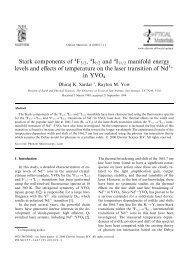Absolute quantum yield measurements in Yb/Ho doped M2O2S (M ...
Absolute quantum yield measurements in Yb/Ho doped M2O2S (M ...
Absolute quantum yield measurements in Yb/Ho doped M2O2S (M ...
Create successful ePaper yourself
Turn your PDF publications into a flip-book with our unique Google optimized e-Paper software.
<strong>Absolute</strong> <strong>quantum</strong> <strong>yield</strong> <strong>measurements</strong> <strong>in</strong> <strong>Yb</strong>/<strong>Ho</strong> <strong>doped</strong> <strong>M2O2S</strong><br />
(M¼Y, Gd, La) upconversion phosphor<br />
G.A. Kumar n , M. Pokhrel, D.K. Sardar<br />
Department of Physics and Astronomy, University of Texas at San Antonio, TX 78249, USA<br />
article <strong>in</strong>fo<br />
Article history:<br />
Received 21 December 2012<br />
Accepted 1 February 2013<br />
Available onl<strong>in</strong>e 9 February 2013<br />
Keywords:<br />
Upconversion<br />
Quantum <strong>yield</strong><br />
Phosphor<br />
Oxysulfide<br />
1. Introduction<br />
abstract<br />
Rare earth <strong>doped</strong> lum<strong>in</strong>escent materials attract a great deal of<br />
attention nowadays because of their numerous applications<br />
<strong>in</strong>clud<strong>in</strong>g display phosphors, security, biomedical imag<strong>in</strong>g, therapy,<br />
solid state lasers, and optical amplifiers [1–3]. Compared to several<br />
other phosphors rare earth <strong>doped</strong> phosphors have found a big<br />
market <strong>in</strong> the photonics <strong>in</strong>dustry due to their ease of synthesis, low<br />
cost of production, photo-stability, non-toxicity and size <strong>in</strong>dependent<br />
optical properties [4]. It should be noted that these superior<br />
properties make them competitors of organic dyes and <strong>quantum</strong><br />
dots; both of which have several limitations [4].<br />
It was found that halides and heavy metal comb<strong>in</strong>ations are<br />
the best materials for efficient lum<strong>in</strong>escence due to their low<br />
vibration frequencies <strong>in</strong> the range of 150–450 cm 1 [5]. <strong>Ho</strong>wever,<br />
many of the halides are air sensitive as well as toxic and several of<br />
them could not f<strong>in</strong>d large scale <strong>in</strong>dustrial applications. Chalcogenides<br />
such as S, Se, Te, etc. are also found to be potential<br />
candidates though the phonon frequency is little higher than<br />
halides [6]. Among chalcogenides, rare earth oxysulfide possesses<br />
several excellent properties such as chemical stability, low<br />
toxicity and can be easily mass produced at low cost. It has<br />
average phonon energy of about 520 cm 1 [7]. For example,<br />
Y2O2S: <strong>Yb</strong>, Er and Y2O2S: Eu are two of the best mass produced<br />
commercial up and down conversion phosphors for applications<br />
such as authentication technology and light<strong>in</strong>g. It was found that<br />
the upconversion brightness of Y2O2S: <strong>Yb</strong>, Er is 6.5 times that of<br />
Y 2O 3: <strong>Yb</strong>, Er [8]. Yocom et al. [9] demonstrated that Y 2O 2S: <strong>Yb</strong>, Er<br />
exhibited 82% brighter output than that of fluoride. Our recent<br />
n Correspond<strong>in</strong>g author. Tel.: þ1 2104585748.<br />
E-mail address: akgsh@yahoo.com (G.A. Kumar).<br />
0167-577X/$ - see front matter & 2013 Elsevier B.V. All rights reserved.<br />
http://dx.doi.org/10.1016/j.matlet.2013.02.001<br />
Materials Letters 98 (2013) 63–66<br />
Contents lists available at SciVerse ScienceDirect<br />
Materials Letters<br />
journal homepage: www.elsevier.com/locate/matlet<br />
Us<strong>in</strong>g the <strong>in</strong>tegrat<strong>in</strong>g sphere technique the absolute <strong>quantum</strong> <strong>yield</strong> <strong>measurements</strong> of the visible<br />
emission bands at 550, 650 and 750 nm <strong>in</strong> <strong>Yb</strong>/<strong>Ho</strong> <strong>doped</strong> <strong>M2O2S</strong> (M¼Y, Gd, La) upconversion phosphor<br />
have been reported for the first time. Observations show that the 750 nm emission <strong>in</strong> La2O2S <strong>doped</strong><br />
with 1 mol% each of <strong>Yb</strong> and <strong>Ho</strong> <strong>yield</strong> the highest efficiency of 0.12% followed by green emission which is<br />
0.065% with 9.5% <strong>Yb</strong> and 0.5% <strong>Ho</strong> <strong>in</strong> the same host. The red emission <strong>in</strong> La2O2S, Y2O2S are nearly 6 times<br />
weaker than green emission, whereas <strong>in</strong> Gd2O2S it is 14 times less efficient mak<strong>in</strong>g Gd2O2S <strong>doped</strong> with<br />
4.5 mol% <strong>Yb</strong> and 0.5 mol% <strong>Ho</strong> as the most efficient s<strong>in</strong>gle color green upconvertor among all three host<br />
compositions studied.<br />
& 2013 Elsevier B.V. All rights reserved.<br />
work [10] demonstrated the application of Gd 2O 2S: <strong>Yb</strong>, Er as<br />
another potential candidate for both up and down conversions. In<br />
all practical phosphor applications, quantification of the light<br />
output is so important that it determ<strong>in</strong>es the light output for a<br />
particular excitation. This quantity def<strong>in</strong>ed as the <strong>quantum</strong> <strong>yield</strong><br />
can be experimentally measured by <strong>in</strong>tegrat<strong>in</strong>g the sphere technique<br />
[11]. In this work, we report the absolute <strong>quantum</strong> <strong>yield</strong> of<br />
<strong>Yb</strong> and <strong>Ho</strong> co <strong>doped</strong> <strong>M2O2S</strong> (M¼Y, Gd and La) phosphors.<br />
2. Materials and method<br />
A high temperature solid state flux fusion method was used for<br />
the phosphor syntheses. The start<strong>in</strong>g materials are Y2O3, La2O3,<br />
Gd 2O 3,<strong>Yb</strong> 2O 3,<strong>Ho</strong> 2O 3, (Sigma Aldrich, all 99.999%), S (powder) and<br />
Na2CO3, K3PO4 (Sigma Aldrich, 99.99%) as flux. More details regard<strong>in</strong>g<br />
the synthesis was reported <strong>in</strong> our previous publications [10].<br />
Crystallographic phase and morphology of the phosphor particles<br />
were obta<strong>in</strong>ed by XRD and SEM methods. A typical XRD pattern<br />
obta<strong>in</strong>ed for Y2O2S: <strong>Yb</strong>, Er phosphor sample is shown <strong>in</strong> Fig. 1,which<br />
is <strong>in</strong> perfect match with standard powder peak positions of Y2O2S<br />
hexagonal phase (JCPDS Card no.26-1422). The XRD results reveal<br />
that the well-crystallized Y2O2S: <strong>Yb</strong>, <strong>Ho</strong> sample is <strong>in</strong> hexagonal<br />
Y2O2S phase with cell parameters a¼b¼0.3852 nm, c¼0.6567 nm.<br />
Accord<strong>in</strong>g to the dynamic light scatter<strong>in</strong>g <strong>measurements</strong> the average<br />
particle size was estimated to be 3.8 mm with a FWHM of<br />
4.9 mm. FE-STEM micrographs obta<strong>in</strong>ed from different locations<br />
show that the material mostly crystallized <strong>in</strong> hexagonal shape.<br />
3. Results and discussions<br />
Fig. 2 shows a comparison of the 980 nm excited upconversion<br />
<strong>in</strong> M 2O 2S: <strong>Yb</strong> <strong>Ho</strong> <strong>in</strong> the 400–850 nm range with an <strong>in</strong>set
64<br />
photograph of the naked eye emission under 100 mW laser<br />
excitation <strong>in</strong> samples Gd2O2S:<strong>Yb</strong>(4.5)<strong>Ho</strong>(0.5) [GOS], La2O2S:<strong>Yb</strong>(8)<br />
<strong>Ho</strong>(0.5) [LOS] and Y2O2S:<strong>Yb</strong>(5)<strong>Ho</strong>(0.5) [YOS].The <strong>in</strong>set also shows<br />
the schematic of the <strong>in</strong>tegrat<strong>in</strong>g sphere setup for <strong>quantum</strong> <strong>yield</strong><br />
<strong>measurements</strong>. In the 500–850 nm range three emission bands<br />
were ma<strong>in</strong>ly observed with 3 Stark components for each of them.<br />
The green band is peaked at 541 with Stark components at 545<br />
and 550 nm and is aris<strong>in</strong>g from 5 F 4- 5 I 8 transition. The red band<br />
has 3 components at 648, 652 and 660 nm and is far weaker<br />
compared to green. The 756 nm is aris<strong>in</strong>g due to the transition<br />
from 5 F4 to 5 I7. The fluorescence branch<strong>in</strong>g ratios of the three<br />
bands are 47.1% (541 nm), 6.6% (648 nm) and 35.6% (756 nm). In<br />
GOS the green emission <strong>in</strong>tensity is 22 times that of red whereas<br />
<strong>in</strong> LOS and YOS it is only 10 times stronger than red emission<br />
mak<strong>in</strong>g GOS a more efficient green upconversion phosphor.<br />
G.A. Kumar et al. / Materials Letters 98 (2013) 63–66<br />
The accuracy of the <strong>quantum</strong> <strong>yield</strong> measurement depends on<br />
various factors such as the excitation power density, temperature<br />
of the sample aris<strong>in</strong>g from high power density excitation, sample<br />
quantity and the reflectivity of the sample holder. In order to<br />
measure the <strong>quantum</strong> <strong>yield</strong> of the emission bands the upconversion<br />
phosphors are equally weighed <strong>in</strong> 0.5 g and packed tightly<br />
<strong>in</strong>side the specially designed powder sample holder which has a<br />
glass w<strong>in</strong>dow for excitation and emission. The holder was placed<br />
at the sample port of the <strong>in</strong>tegrat<strong>in</strong>g sphere and excited with a<br />
980 nm laser of 0.5 W/cm 2 power density. Emission spectra were<br />
collected <strong>in</strong> the 500–1000 nm range with all three phosphor<br />
samples. In order to overcome the heat<strong>in</strong>g effect all <strong>measurements</strong><br />
are done with<strong>in</strong> a short time period. Further, s<strong>in</strong>ce the<br />
powder was tightly packed <strong>in</strong>side the sample holder error from<br />
the scatter<strong>in</strong>g was negligible. To measure the absorbed photons<br />
Fig. 1. XRD pattern of the Gd 2O 2S: <strong>Yb</strong>/Er sample. Vertical l<strong>in</strong>es show the standard peak positions of the Gd 2O 2S (JCPD File no. 26-1422). The left <strong>in</strong>set shows crystal<br />
structure of Gd2O2S <strong>in</strong>dicat<strong>in</strong>g the locations of Gd (P<strong>in</strong>k), O (Red) and S (Yellow) atoms. Right <strong>in</strong>set shows the FE-SEM image of the phosphor particles. (For <strong>in</strong>terpretation<br />
of the references to color <strong>in</strong> this figure legend, the reader is referred to the web version of this article.)<br />
Fig. 2. Comparison of the upconversion emission spectrum of the phosphor under 980 nm laser excitation. Inset shows the green emission at 980 nm excitation with<br />
20 mW of power and the <strong>in</strong>tegrat<strong>in</strong>g sphere experimental setup for <strong>quantum</strong> <strong>yield</strong> <strong>measurements</strong>.
Quantum Yield (%)<br />
0.04<br />
0.03<br />
0.02<br />
0.01<br />
0.00<br />
GOS<br />
0 2 4 6 8 10 12 14 16 18 20<br />
<strong>Yb</strong>/<strong>Ho</strong> Ratio<br />
YOS<br />
LOS<br />
Fig. 3. (a) Quantum <strong>yield</strong> of green emission as a function of <strong>Yb</strong>/<strong>Ho</strong> ratio <strong>in</strong> the<br />
three phosphor host compositions. (b) Quantum <strong>yield</strong> of red emission as a<br />
function of <strong>Yb</strong>/<strong>Ho</strong> ratio <strong>in</strong> the three phosphor host compositions studied. (c)<br />
Quantum <strong>yield</strong> of 756 nm emission as a function of <strong>Yb</strong>/<strong>Ho</strong> ratio <strong>in</strong> the three<br />
phosphor host compositions studied.<br />
the excitation laser profile was collected from a fully reflect<strong>in</strong>g<br />
BaSO4 background which shows no absorption at 980 nm excitation.<br />
The difference between the background and sample at the<br />
excitation wavelength gives the absorbed photons, whereas<br />
the emitted photons can be calculated from the area under the<br />
emission spectra. All spectra are corrected for spectral response<br />
G.A. Kumar et al. / Materials Letters 98 (2013) 63–66 65<br />
of the fluorimeter and <strong>in</strong>tegrat<strong>in</strong>g sphere. The <strong>quantum</strong> <strong>yield</strong> is<br />
obta<strong>in</strong>ed as the ratio of the number of photons emitted vs.<br />
number of absorbed photons. The spectra collected us<strong>in</strong>g <strong>in</strong>tegrat<strong>in</strong>g<br />
sphere are shown <strong>in</strong> Fig. 3. Follow<strong>in</strong>g this procedure we<br />
obta<strong>in</strong>ed the <strong>quantum</strong> <strong>yield</strong> for various <strong>Yb</strong>/<strong>Ho</strong> ratios and the<br />
results obta<strong>in</strong>ed for 541, 652 and 756 nm bands are summarized<br />
<strong>in</strong> Fig. 3a, b and c. Based on this, the green emission efficiency<br />
shows an <strong>in</strong>creas<strong>in</strong>g tendency <strong>in</strong> Y 2O 2S and La 2O 2S whereas <strong>in</strong><br />
Gd2O2S it decreases with higher <strong>Yb</strong>/<strong>Ho</strong> ratio. On the other hand,<br />
the red upconversion efficiency shows a decreas<strong>in</strong>g tendency<br />
with <strong>Yb</strong>/<strong>Ho</strong> ratio <strong>in</strong> all three phosphors.<br />
In all compositions the 756 nm emission <strong>quantum</strong> <strong>yield</strong> shows<br />
highest value at <strong>Yb</strong>/<strong>Ho</strong> ratio of 1 and thereafter decreases except<br />
<strong>in</strong> the case of LOS where it shows a slightly <strong>in</strong>creas<strong>in</strong>g tendency<br />
from <strong>Yb</strong>/<strong>Ho</strong> ratio of 16. Among all emission bands observed the<br />
756 nm emission <strong>in</strong> LOS shows the highest value of <strong>quantum</strong><br />
<strong>yield</strong> 0.12% which is nearly 2 times more efficient than the green<br />
emission <strong>in</strong> LOS. In all three compositions 0.5 mol% <strong>Ho</strong> is<br />
the optimum concentration for best efficiency and this result is<br />
<strong>in</strong> agreement with previous observation [12]. Concentration<br />
quench<strong>in</strong>g aris<strong>in</strong>g due to the non radiative energy transfer<br />
<strong>in</strong>teractions between the emitt<strong>in</strong>g ions can suppress the emission<br />
<strong>in</strong>tensity and hence efficiency decreases considerably.<br />
Recently we explored <strong>in</strong> detail the <strong>quantum</strong> <strong>yield</strong> of various<br />
emission bands <strong>in</strong> the UV–vis–NIR region as a function of the<br />
excitation power density <strong>in</strong> M 2O 2S <strong>doped</strong> with various <strong>Yb</strong>/Er and<br />
<strong>Yb</strong>/<strong>Ho</strong> and compared them with the well know NaYF4:<strong>Yb</strong>(20%)/<br />
Er(2%) host [13,14]. Accord<strong>in</strong>g to this observation the green<br />
upconversion efficiency at 0.5 W/cm 2 power density was estimated<br />
to be 0.157% and 0.015% respectively <strong>in</strong> La 2O 2S:<strong>Yb</strong>(9%)/<br />
Er(1%) and NaYF4:<strong>Yb</strong>(20%)/Er(2%). Based on this comparison<br />
La 2O 2S:<strong>Yb</strong>(9%)/Er(1%) is the most efficient green emitter followed<br />
by La2O2S:<strong>Yb</strong>(9.5%)/<strong>Ho</strong>(0.5%).<br />
4. Conclusions<br />
In conclusion we have studied the 980 nm excited external<br />
upconversion <strong>quantum</strong> <strong>yield</strong> of <strong>Yb</strong>/<strong>Ho</strong> <strong>doped</strong> <strong>M2O2S</strong> (M¼Gd, Y,<br />
La) as a function of the <strong>Yb</strong>/<strong>Ho</strong> ratio and found functional<br />
dependence of the <strong>quantum</strong> <strong>yield</strong> of 541, 658 and 756 nm<br />
emission bands with <strong>Yb</strong>/<strong>Ho</strong> ratio. Though most of the phosphor<br />
shows <strong>in</strong>tense green upconversion which was visible to the naked<br />
eye, the 756 nm emission <strong>quantum</strong> <strong>yield</strong> <strong>in</strong> La 2O 2S is nearly two<br />
times higher than the green emission.Gd2O2S:<strong>Yb</strong>(4.5%)<strong>Ho</strong>(0.5%) is<br />
the brightest s<strong>in</strong>gle color green upconversion phosphor with<br />
green efficiency 14 times higher than red.<br />
Acknowledgment<br />
This work was supported by the National Science Foundation<br />
Partnerships for Research and Education <strong>in</strong> Materials (PREM)<br />
Grant no. DMR-0934218.<br />
References<br />
[1] Dong G, Wu B, Zhang F, Zhang L, Peng M, Chen D, et al. Broadband near<strong>in</strong>frared<br />
lum<strong>in</strong>escence and tunable optical amplification around 1.55 mm and<br />
1.33 mm of PbS <strong>quantum</strong> dots <strong>in</strong> glasses. J Alloys Compd 2011;509:9335–9.<br />
[2] Prashantha SC, Lakshm<strong>in</strong>arasappa BN, Nagabhushana BM. Photolum<strong>in</strong>escence<br />
and thermolum<strong>in</strong>escence studies of Mg 2SiO 4:Eu 3 þ nano phosphor.<br />
J Alloys Compd 2011;509:10185–9.<br />
[3] Liu Q, Chen M, Sun Y, Chen G, Yang T, Gao Y, et al. Multifunctional rare-earth<br />
self-assembled nanosystem for tri-modal upconversion lum<strong>in</strong>escence/fluorescence/positron<br />
emission tomography imag<strong>in</strong>g. Biomaterials 2011;32:8243–53.<br />
[4] Meng W, Gopal A, Clevenger A, Maoc C, Xu S. Upconversion nanoparticles:<br />
synthesis, surface modification and biological applications. Nanomedic<strong>in</strong>e:<br />
Nanotech Biol Med 2011;7:710–29.
66<br />
[5] Chen Wei. Doped nanomaterials and nanodevices.Photonics and Nanodevices,<br />
vol. 2. California, CA: American Scientific Publishers; 2010.<br />
[6] Bartolo BD. Spectroscopy of solid-state laser type materials. New York, NY:<br />
Plenum Press; 1987.<br />
[7] Garlick GFJ, Richards CL. Studies of the red anti-stokes emission of erbium<br />
ions <strong>in</strong> the Y 2O 2S: Er, <strong>Yb</strong> phosphor system. J Lum<strong>in</strong> 1974;9:432–9.<br />
[8] Xi-xian L, Wang-he C. Sci Ch<strong>in</strong>a Ser B Chem 2007;50:505–13.<br />
[9] Yocom PN, Wittke JP, Ladany I. Rare-earth-<strong>doped</strong> oxysulfides for GaAspumped<br />
lum<strong>in</strong>escent devices. Metall Trans A Phys Metall Mater Sci<br />
1971;2:763–7.<br />
[10] Kumar GA, Pokhrel M, Sardar DK. Synthesis and spectroscopy of color tunable<br />
Y 2O 2S:<strong>Yb</strong> 3 þ ,Er 3þ phosphors with <strong>in</strong>tense emission. J Alloys Compd<br />
2012;513:559–65.<br />
G.A. Kumar et al. / Materials Letters 98 (2013) 63–66<br />
[11] CDe J Mello, Wittmann FH, Friend RH. An improved experimental determ<strong>in</strong>ation<br />
of external photolum<strong>in</strong>escence <strong>quantum</strong> efficiency. Adv Mater<br />
1997;9:230–2.<br />
[12] Xi-Xian, Cao W-He. Upconversion lum<strong>in</strong>escence of holmium and ytterbium<br />
co-<strong>doped</strong> yttrium oxysulfide phosphor. Mater Lett 2007;61:3696–700.<br />
[13] Pokhrel M, Kumar GA Sardar DK. High upconversion <strong>quantum</strong> <strong>yield</strong> at low<br />
pump thres hold <strong>in</strong> Er 3þ /<strong>Yb</strong> 3þ <strong>doped</strong> La 2O 2S phosphor. Mater Lett; accepted<br />
for publication.<br />
[14] Kumar GA ,Pokhrel M Sardar DK. Mid <strong>in</strong>frared emission and measurement of<br />
the 980 nm excited up and down conversion efficiency <strong>in</strong> La 2O 2S:<strong>Yb</strong>/Er<br />
phosphor. J Electrochem Soc; submitted for publication.


